ZCC: Reduce variances, by all means

Consultant tells members of the Philadelphia Zoning Code Commission that often the process is the problem.
Feb. 11, 2009
By Thomas J. Walsh
For PlanPhilly
Philadelphia’s Zoning Code Commission enjoyed a lively discussion Wednesday morning centering around a question at the heart of the multi-year code re-write: “Should we develop a code that creates a dramatic reduction in the need for variances?”
The answer, in short, is yes.
Don Elliott, senior consultant for the Denver-based Clarion Associates, one of the four consulting firms hired to do the city’s code re-write, introduced the topic by relating his observations of how Philadelphians at code-user interviews and community outreach meetings feel about zoning here. “In many respects the process is the problem,” he said, or at least the perception of problems. For Elliott, it’s easy to see why, when you compare Philadelphia to other major cities.
“Most major cities don’t grant use variances,” Elliott said. “You need to get a re-zoning instead.” Likewise with “minor dimensional variances,” such as encroachments and ADA-related features altering setbacks – some cities allow staff to make decisions that fall under this category. “We’re not gonna gear up the business of government to talk about minor dimensional variances.”
Minor changes to “nonconforming” buildings? Same deal. Philadelphia was up and running as a major city long before any kind of zoning was put in place, so of course there will be buildings that are larger, or taller, or different somehow from the way they would be if strict conformance to code was enforced. It’s a waste of time to worry about them, he said.
Applications for various low level or short-term, temporary uses of sites can be made more broad and looser, as well. As for decks – roof decks, back decks, etc. – Elliott conceded that Philly has a lot of properties with very small lots and “constrained situations. Nevertheless most cities don’t discuss decks” at their Zoning Board hearings, he said. They are dealt with by staff, and like other staff decisions, neighbors can appeal them if they desire.
“This is not an easy issue,” Elliott said. Chicago, a city with an envied zoning code, had about 1,200 re-zonings last year. “Is that any better?”
The key to an efficient system is large citizen involvement upfront – input into standards, not individual projects. Public involvement decreases as you funnel forward toward completing plans.
Other cities also recommend to developers that they talk to neighbors before applying for a re-zoning. Some even say an application is not complete until it is documented that these kinds of discussions took place.
Other options include “call-up provisions” or “bump-up provisions.”
“Believe it or not, most planners know what they are doing,” Elliott said. Call-ups mean letting staff make decisions and create “outs” – that is, a decision is not final until the Planning Commission or City Council decides if they want to “call it up” for further discussion. A bump-up is a staff decision that is not final for, say, two weeks. If no opposition is voiced, the matter is bumped up to the Zoning Board for a hearing.
These are all measures that can be taken to dramatically reduce the need for variances in a new Philadelphia zoning code.
A few of the commissioners did not necessarily agree. Zoning attorney Richard DeMarco said a city like Philadelphia has acres of shell buildings that could be converted to beautiful residential spaces, as evidenced over the past decade with condominiums and apartment buildings that have sprouted all over Center City and have begun to migrate south into places like Bella Vista, and north into emerging neighborhoods like Northern Liberties.
City Councilman and Commissioner Brian O’Neill politely objected to that point. “It’s incorrect to say you wouldn’t have these conversions without use variances,” O’Neill said, adding it was actually easier, again pointing to Chicago, another city with massive amounts of remaining industrial properties. “Plus, if we’re doing something for a long time and others cities are not, we need to take a long hard look at why.”
Commissioner Andy Toy, an officer with the Logan Square neighborhood group, said he hears consistent concern about a politicized process. “I’ve heard that people would rather go through a variance discussion than [through] City Council [for the necessary zoning change imprimatur].”

Elliott explained that when you overhaul a zoning code, you can open up whole new classes of uses, and winnow down the best categorizations. “Zoning by variance” is essentially “governing the city by variance,” he said. Whenever possible, avoid the “rifle-shot exceptions” to the rules.
“There’s an awful lot of this city that is industrial and won’t ever be again, in all likelihood,” said Commissioner Alan Greenberger, executive director of the Planning Commission, echoing remarks he has made recently in other public meetings. “If a parcel of a development is put forward as a zoning change, and we say that makes sense,” then fine, he said. But it would then follow that other parcels should be treated the same, though he admitted that this would “bump up against neighbors to control the process.”
“The answer is obviously yes, we should cut down on variances,” said one animated commissioner, Greg Pastore. “But we don’t want to have spot re-zoning,” and there needs to be an established line of what is new general zoning to benefit the city and what is spot zoning. “In the future, you still want to maintain relief for minor changes to the code and minor changes to the mapping, you don’t want to have a whole lot of variances.”
Pastore, a property owner and resident of Bella Vista, knows from variances, and is well aware that anyone with clout can obtain permission – or skirt the rules. “There’s developer clout and there’s anti-developer clout,” he said. “Fairness dictates that we have to write rules” that use variances based on financial “hardship” cases only. “If you want a restaurant, find a place in the city where you can do a restaurant.”
The lone developer on the commission, John Westrum, weighed in. “As a user of the code, the answer is yes” – get rid of zoning by variance, he said. “As a group we need to realize who the customer is and who the user is. Transparency and predictability is what we’re trying to do here.
“Ultimately as an investor and someone who has to put my money where my mouth is … we want to make sure we know what will be predictable and transparent. The problem is this city manages everything as an exception.”
He went on: “We don’t want to be a city of BANANAs.” (Developer shorthand for “build absolutely nothing anywhere near anything.”) “The mayor yesterday talked about competitiveness. If this city is going to be competitive, we have to make sure we’re going to be attractive.” If there are 400 steps before moving dirt, outside investors are simply not going to invest here. It’s an argument that’s tried and true, but in the context of a discussion on variances, he seemed to hold his fellow commissioners’ attention pretty well.
Zoning attorney and Commissioner Peter Kelsen, who represents developers in his law practice, said the entire effort is to create documents and text that are easy to use and predictable. “But Alan [Greenberger] and others have said all along that you’re going to have an intensive re-mapping, too. Your text and your maps should create a scenario where you don’t need to get major zoning change or variances.”
One thing that constantly comes out on both sides of the equation, between neighborhoods and the developers, is that the process needs to be as de-politicized as much as any city government process can be, Kelsen said. “Meaningful, manageable and time sensitive. You’ve got to have a date certain, yea or nea” for proposed projects.
City Councilman and Commissioner Bill Green also agreed with Westrum. “Let’s change the zoning once. I just want to move forward with our broad outline and have [the zoning and planning staffs and the consultants] get to work.”
Green’s sense of urgency was a result of Greenberger’s remarks earlier in the meeting about the ZCC’s budget.
Because the ZCC “is a kind of curious creature of government” – existing for a finite amount of years, with Executive Director Eva Gladstein as its only full-time employee, Greenberger said he was wasn’t quite sure if the ZCC needed to submit scenarios for budget cuts to Mayor Michael Nutter, as he has asked all departments to do.
“The potential impact has to do with timing, making an educated guess at what it’s likely to cost,” Greenberger said, reminding the assembled that cost estimates do not include the re-mapping work that would come after the code is re-written. “The cuts reflect potentially our ability to get it done on time – June 30, 2010 – but it’s a bit of an artifice. It costs what it costs, and the mayor said no decisions have been made” on any kind of further cuts.
“We think it is probably close to the time we ought to do a more formal brief of the Council and the mayor about what it’s going to take to get this done,” Greenberger said, adding it would likely come sometime in the Spring.
“While we have the time and resources, let’s get something done.” Green said.
Code user interviews. Gladstein reported that Commissioner Natalia Olson de Savyckyj was appointed chair of the Civic Engagement Committee, and that a 12- or 15-page executive director update on the process would be forthcoming. She expects another half dozen interviews and to wrap up the process by mid-March.
Civic engagement. Consultant Beverly Harper, running the civic engagement efforts, said four district meetings have been held, with the fifth one scheduled for Wednesday night. There have been about 170 participants, with more than 50 percent completing an evaluation form.
On the positive side, the forms indicate very high satisfaction with the discussions and the facilitation, and many of those attending commented that the workshops had a much higher level of participation than expected.
The downside is no shocker: people generally believe that the zoning process is “ambiguous, politically driven and gives an advantage to large developers” over others, including smaller developers.
“The little orange signs are not enough,” Harper said, referring to the required stickers in front windows or on doors that post what is or about to happen. “They want something providing a clear, fair and efficient zoning approval process.”
She also reported more than 1,200 responses so far on the online survey (www.zoningmatters.org), with responses very similar to the feedback from the workshops. There are currently Spanish and Chinese language versions of the survey, with others in Ukrainian and Korean coming.
Contact the reporter at thomaswalsh1@gmail.com.
WHYY is your source for fact-based, in-depth journalism and information. As a nonprofit organization, we rely on financial support from readers like you. Please give today.



